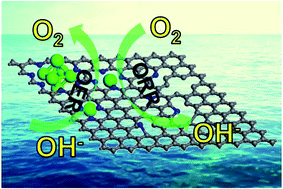Preparation of Co–N carbon nanosheet oxygen electrode catalyst by controlled crystallization of cobalt salt precursors for all-solid-state Al–air battery†
Abstract
Production of bifunctional catalysts for catalyzing both the oxygen reduction reaction (ORR) and oxygen evolution reaction (OER) is highly advisable but challenging with respect to the applications of these catalysts in renewable energy conversion and storage technologies. Herein, we prepared highly reactive and stable cobalt-embedded nitrogen-rich carbon nanosheets (Co–N/CNs). Based on density functional theory (DFT) calculations and experiments, the as-prepared Co–N/CNs showed outstanding catalytic activities toward both OER and ORR. The optimized Co–N/CNs-800 catalyst revealed outstanding bifunctional catalytic activities for both ORR and OER with high catalytic efficiency and long-term durability, which were even comparable with those of the state-of-the-art Pt/C and RuO2 catalysts. Furthermore, we observed that different cobalt salt precursors affected the size of Co nanoparticles, and both ORR and OER catalytic activities displayed completely consistent variations (sulfate < acetate < chloride < nitrate). An all-solid-state Al–air battery device comprising this hybrid catalyst showed superior performance when compared with the device containing the Pt/C catalyst.



 Please wait while we load your content...
Please wait while we load your content...